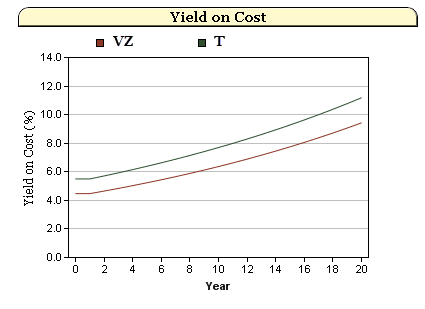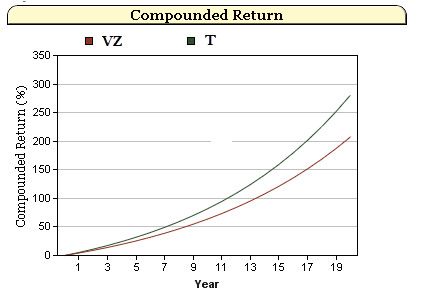When looking to build a long-term portfolio of stocks that pay high dividends, investors usually come up with a mix of stocks that either have high dividend yields or high dividend growth rates. However, it is not easy to analyze and compare how various dividend payers will pay off in the long-run. That is why it is important to look at both dividend yield and growth through time and calculate some objective numbers. For this article I want to look at possible payoffs for Verizon (VZ) and AT&T (T).
| VZ: |
| Div Yield | 1 Yr Div
Growth Rate | 5 Yr Div
Growth Rate |
| 4.3% | 2.5% | 4.0% |
| T: |
| Div Yield | 1 Yr Div
Growth Rate | 5 Yr Div
Growth Rate |
| 5.3% | 2.3% | 3.8% |
Verizon and AT&T have similar dividend profiles. AT&T does pay a higher dividend while Verizon has had slightly faster dividend growth rates over the past one and five years. This presents a good case study in which company might give the investor a greater return due to dividends over time. More specifically, I want to measure the Yield on Cost (YOC) and how it changes over time as well as the compounded annual return due to dividends. The YOC simply measures the annual dividend divided by the original investment in the company’s stock.
For this example I will assume that Verizon's dividend grows at the five year rate of 4% and AT&T maintains a growth rate of 3.8%. I ran the following results in our free calculator called Dividend Yield And Growth.

Notice that the YOC for Verizon never breaks even with AT&T even though Verizon has a higher dividend growth rate. Let's also take a look at the compounded returns through time.

Not surprisingly the compounded rate of return does not break even either. The higher growth rate of Verizon is just not enough to offset the higher dividend yield of AT&T.
Many investors believe that AT&T will not be able to continue growing its dividend going forward. In fact, many expect a dividend cut. Their payout ratio is already above 100%, which means their dividend payments are above their net income. So what do the numbers look like if we assume that AT&T's dividend growth rate will be 2% over the next 20 years while Verizon's is 4%? Using these assumptions it takes 11 years for Verizon to break even with AT&T in terms of compounded returns. This just shows how important the dividend growth assumptions are.
When constructing a dividend portfolio for the long-run, it is important to keep in mind just how long it might take for a lower dividend yield to catch up with a stock that pays a higher yield. That lower yield stock might not be worth putting in your portfolio until the dividend yield has risen enough to make it worthwhile or at least until the dividend growth rate picks up.
Retirement Planning Software | Financial Planning Software